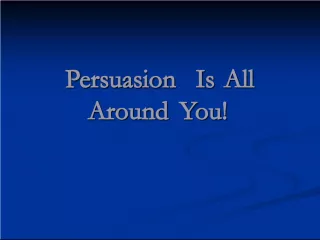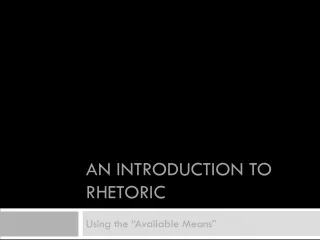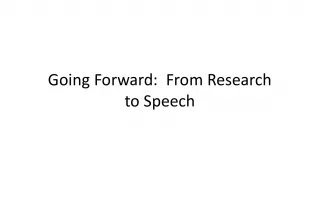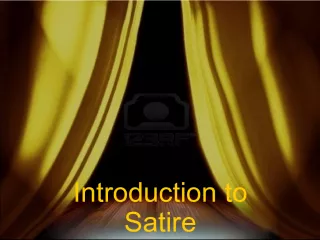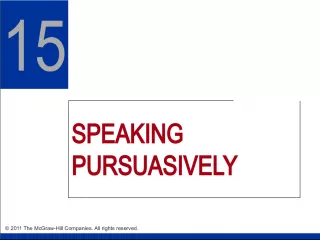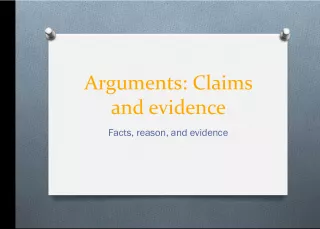The Art of Persuasion
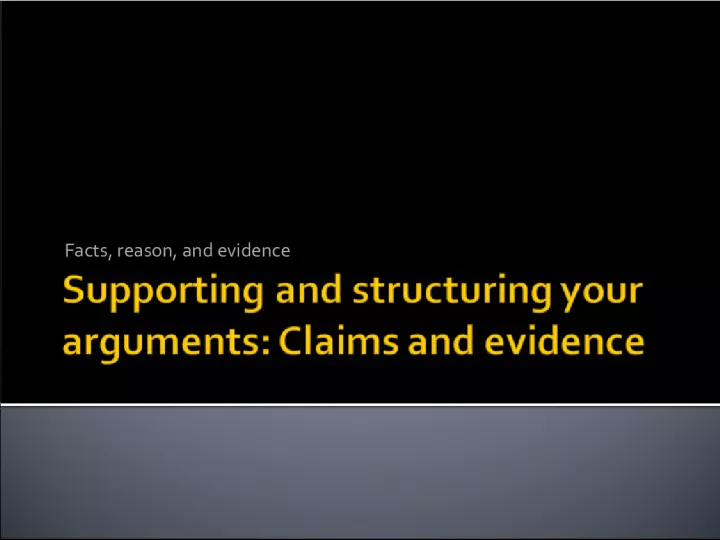

Everything can be argued and rhetoric plays a crucial role in persuasive communication. The right combination of evidence and argument is key, and experience helps in finding the perfect fit for a given audience and situation.
- Uploaded on | 0 Views
-
 fatima
fatima
About The Art of Persuasion
PowerPoint presentation about 'The Art of Persuasion'. This presentation describes the topic on Everything can be argued and rhetoric plays a crucial role in persuasive communication. The right combination of evidence and argument is key, and experience helps in finding the perfect fit for a given audience and situation.. The key topics included in this slideshow are . Download this presentation absolutely free.
Presentation Transcript
1. Facts, reason, and evidence
2. Rhetoric = how something is said art of persuasive communication Argument = what is said Claims followed by evidence that lead to a conclusion. Everything is rhetorical Everything is an argument
3. Finding the right fit of evidence to argument is easier the more experience you have with a given audience, purpose and rhetorical situation. This experience can come in the form of reading and writing, so you probably already know what evidence is best in certain situations.
4. Think about what counts for evidence in a television commercial? Current commercials rely on visual metaphors that associate a product with something else that we might find pleasant (prosperity, popularity, well-being, etc.) We have already seen some contemporary videogame commercials. Commercials weren’t always like this. Sure, advertisers associated their products with other things, but they were less metaphorical. They used slogans, jingles, televisions and movie stars, and cartoon characters (some commercials still do this today). Atari VCS (2600) from 1981 Atari 2600 from 1982 Pole Position for Atari 1983
5. Commercials Essay in history Newspaper article Television newscast Essay in English Proposal in Business Scientific Experiment Letter to the Editor Blog Grocery List Essay in political science
6. Your thesis (your main point) should be supported by evidence that is appropriate to your audience. Your point needs the best support possible, otherwise it will topple over.
7. In an argument, each claim or statement should be backed up by some sort of evidence. These claims+evidence become part of the more comprehensive support for your argument. Evidence can be categorized into two types: Hard evidence and Reason. Hard evidence is usually used as a logical appeal, but all support can be used to appeal to either logos, ethos or pathos.
8. Reason • Anecdote • Analogy/Comparison • Consequences/Effects • Contrasts • Categories/Models • Examples • Precedent • Quotes Hard Evidence • Facts • Statistics • Surveys/Polls • Testimonies Narratives Interviews • Experiments • Textual Evidence
9. Generally speaking… Academic writing privileges hard (and textual) evidence News sources privilege interviews and expert opinion
10. Take a moment to Scan posts in this thread about the wildcat play in Madden 10 Scan posts in this thread on Gamespot as to why FPS (first-person shooters) aren’t replayable. Scan posts in this thread at ElitistJerks (they are a World of Warcraft guild) about earning gold. Scan posts in this thread from Gamespot as to why Left 4 Dead is racist.
11. The easiest way to think about how to apply this in your own writing is to consider each paragraph its own claim+evidence device. Each paragraph should rely on one primary strategy to add support for a thesis by doing the following: 1. Connect the claim+evidence to the thesis, usually through metadiscourse. 2. Clearly stating the claim. 3. Provide evidence that is appropriate to the rhetorical situation (writer, purpose, audience). ▪ Consider a strategy from the means of support
12. In an argument , you base a claim+evidence on certain premises. If these premises are universally true or are comprehensively connected, then it is a syllogism
13. If premises in an argument are only probable, then you have an enthymeme. Enthymemes are arguments that blend claims+evidence together based on the following: Probability – there is probable but not universal precedence or likelihood that claim and evidence are connected. Audience assumptions – the writer assumes the audience will agree with the premise, claim or evidence.
14. Corporations want to make a profit more than they want to do good Corporations will take what they want in order to make a profit Corporations are bad Corporations are bad
15. Most arguments rely on enthymemes rather than syllogisms because stating/restating every universalism would be boring to read and not really necessary for intended audiences. Let’s look at some advertisements: To read an argument via enthymemes, ask: Why aren’t the premises revealed? What is the probability that this is true/known given the intended audience? Is it an effective argument?
20. A thesis needs support, and this support comes from claims and evidence. Claims need to be controversial and debatable for them to be useful in an academic argument Controversial – there is disagreement (“12 inches makes a foot” is not controversial) Debatable – there can be differing viewpoints (“I love ice cream!” is not debatable) Claims also need to be explicitly stated for most audiences.
21. Claims and evidence have warrants – the assumptions or basis for your argument. Sometimes these are unstated (Remember the enthymemes?) Warrants sometimes need to be stated when certain audiences might be particularly unfamiliar or unreceptive to your claims/evidence.
22. Overweight people should exercise more Variations of syllogisms of this enthymeme: If you are overweight, you will not attract a lover (warrant = want to attract a lover) Exercise will help you lose weight (warrant = unless you have an illness or medical disposition towards weight gain) Exercising will help you attract a lover Overweight people live shorter lives (warrant = you want to live longer) Exercise increases the body’s resilience to disease (warrant = unless you have another medical condition that makes you susceptible to disease) Exercise will help you live longer, counteracting being overweight Exercising will help you lose weight (warrant = you want to lose weight) Riding a bike is exercise (warrant = you are physically able to ride a bike) Riding a bike will help you lose weight
23. Notice that most of the warrants are things that you might not have thought about unless you had considered the full syllogism of the claims and evidence. Also, notice that by uncovering these syllogisms and their associated warrants, you may consider your argument differently.
24. There are two easy strategies to get at your warrants and find some potentially problematic issues with your argument without going to all the work of writing out syllogisms: 1. Contrary Position – consider a contrary position of a claim or evidence Contrary claim: People should not exercise more (“Since I sell diet pills, exercising effects the number of pills I sell, so don’t exercise more.”) 2. Alternative Assumptions – imagine differing contexts or situations in which the claim or evidence would need to be known. Alt. assumption: Readers of Runner’s World should not exercise more. (“They are exercising enough as is”) Alt. assumption: People should exercise more because it is good for the exercise equipment industry. (“external impact from an individual activity”)
25. We cannot roundup, manage, control, or otherwise articulate all assumptions and warrants because we would never get to our main point – SO – we have Qualifiers: Few More or less Often It is possible In some cases Perhaps Rarely Many Sometimes It seems In the main Possibly Some Routinely For the most part It may be Most If it were so One might argue Under these circumstances Modals (should, would, could, might)
26. To persuade those who haven’t made up their mind (and even those who have), it is important to demonstrate to your audience that you understand and have considered both sides of an issue. For this reason, it is important to introduce the opposition and write about the ways in which its arguments are based on false assumptions, fallacies in logic, or errors in judgment. There are many strategies for writing a counterargument into your work, so picking the right strategy relies on properly reading the rhetorical situation.
27. Claims should be stated clearly and qualified carefully. Claims should be supported with evidence and good reasons. Claims and reasons should be based on assumptions readers will likely accept. Effective arguments respectfully anticipate objections readers might offer.
28. The five part theme (or five paragraph essay) gives space to employ the thesis, claim, support form in an easy to write (and read) manner. Many hate this, many love this, but recognize the following: Real world arguments (outside of the university) rarely follow the format, if at all. Sure, they have all or most of the elements, but they don’t follow the structure. Arguments within the university often have genre constraints that prevent the structure from working as intended. It is taught because it is an easy form to understand.
29. Analysis – Separating the parts to make (a) sense of the whole. Examples include, a rhetorical analysis, or movie review. Critique – Separating a predetermined list of the parts to make a judgment about the whole. Synthesis – Adding multiple analyses or multiple parts to make a whole argument. Examples include literature reviews, research “reports.” Any analysis or synthesis is an argument, needing a thesis, claims, evidence, and awareness of warrants appropriate to the audience the argument is to.
30. Look at game forums for posts. General game sites Gamespot , IGN , 1up Popular games Madden , World of Warcraft , Sims 3 What types of evidence do gamers most use to support their claims. Look at the “means of support” for how to describe this evidence. Use examples from the posts to make your claims. Do they qualify their arguments? What assumptions do they make about their audience? In other words, what are the warrants of a claim or the evidence? Thesis: Are the arguments effective? Why/why not?
31. Scan posts in this thread on Gamespot as to why FPS (first-person shooters) aren’t replayable. Scan posts in this thread at ElitistJerks (they are a World of Warcraft guild) about earning gold. Scan posts in this thread from Gamespot as to why Left 4 Dead is racist. What types of evidence do gamers most use to support their claims. Look at the “means of support” for how to describe this evidence. Use examples from the posts to make your claims. Do they qualify their arguments? What assumptions do they make about their audience? In other words, what are the warrants of a claim or the evidence? Thesis: Are the arguments effective? Why/why not?
